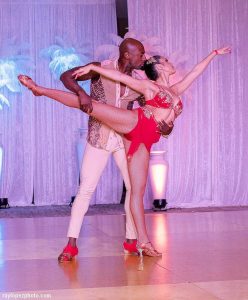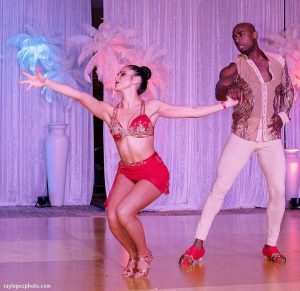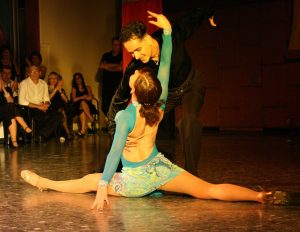Sometimes the most valuable lessons in leadership and followership come from outside the office.
Meet Mario Che and Jeanette Fiallo, Latin dancers from Florida.


What this talented couple teaches about the relationship between a leader and a follower can apply not only on the dance floor but to everyday relationships, including those at the office.
Mario and Jeanette came up with a unique way to teach connection, trust, and the art of leading and following. In their dance classes, they explain five basic rules of leadership and followership, teach their students a few basic moves…then blindfold the follower.
The concept seems scary and impossible at first. But the truth is if we stick to the rules and put our trust in each other, we can lead and follow flawlessly and productively. Turns out we can even do it blindfolded, as long as we develop a relationship where the roles of a leader and a follower are clear.
Here are the five rules of leadership and followership that can transform business and personal relationships. From Jeanette and Mario’s dance floor to your workplace.
Rule #1. The leader creates the connection, the follower maintains it.

In business relationships, as in partner dance, teamwork is everything. In order for the partnership to work, having clear roles is important. There has to be a leader and there has to be a follower. And while sharing ideas, allowing creativity, and welcoming input from everyone is essential, there can’t be too many cooks in the kitchen.
Someone has to lead with a vision for whatever task is at hand and someone has to follow that vision. The leader is responsible for establishing the dynamics and the connection between him or herself and the follower. The follower is responsible to maintain that connection. That means that while the leader is contemplating a new move, thinking over an idea, or coming up with a plan, it’s up to the follower to keep the leader on track and offer support by maintaining the connection. That connection is essential to the support system that ensures the productivity of the whole team.
“Good, skilled followers are able to nurture good leadership, by invisibly helping keep a novice leader upright and on track,” writes business insider and consultant Rob Asghar in his Forbes article “Why Followership Is Now More Important Than Leadership.”
Asghar goes on to explain that the roles of leader and follower do not mean one is in a dominant one and one is submissive.
“A skilled follower helps an inexperienced leader to shine,” he says. “As the leader grows in skill, he or she is then able to help the followers to shine. And as they all grow in experience and skill, the interplay grows more productive and life-affirming.”
Rule #2. The follower is the extension of the leader’s intention.

Being a leader does not mean being responsible for everything that goes on in the office or company. On the contrary, the solid supportive relationships between the leaders and the followers ensure that ideas, tasks, and actions will develop, advance, and flourish.
In dance, once a leader initiates a movement, he or she does not need to execute and follow it all the way through. That is a follower’s job. The follower is the supporter, the developer, the executor of the initial movement.
The same rule applies in business. Once a leader initiates an action the followers extend it. The followers can add their own spin on the action, develop it, grow it, and expand it. The followers are the ones who essentially complete the action.
In effective partnerships, leaders set forward their intentions and the followers act as an extension of those intentions.
One way to ensure that such initiation-extension relationship works effectively is for leaders to adopt an intent-based leadership style.

“Intent-based leadership creates an environment for people to contribute so they feel valued and encouraged to reach their potential,” says Rhett Power, head coach at Power Coaching and Consulting and the author of The Entrepreneur’s Book of Actions. “Intent-based leadership is about designing an environment where people give intent to each other and they feel valued and proud of their work. [This type of] leadership is about giving control and the decision-making power to people who maintain the information.”
In other words, when a leader initiates an action she needs to release control and trust her partners to execute and complete the action without constant supervision. Giving the followers freedom, trusting them, and empowering them with the process is what makes the dance of execution work.
Rule #3. The follower is responsible for her weight unless it is taken away from her.

Sometimes in dance, it seems as if the leader is carrying all of the follower’s weight. It only looks that way to an untrained eye. In reality, a skillful follower will always carry his own weight. This rule is an extension of Rule #3, where the leader initiates the movement and the follower carries his own weight in the execution process.
This is where the followers really shine. Some of the most beautiful dance figures involve followers looking as if they’re releasing all control and are letting their partners do the work. That’s an illusion. I reality it is the follower who is taking control of her own actions and is carrying the weight.
This rule goes a long way off the dance floor, too. The follower must carry her own weight without relying on the leader for constant support and guidance.
Gwen Moran, a business writer and a small business influencer, defines critical thinking and courage, among other things, as essential qualities of a great follower.
“In order to be a good follower, you need to be able to think for yourself,” she says. “It means being engaged. It means paying attention.”
Moran identifies awareness, diplomacy, and collaboration as other important aspects of a follower’s role. All of the five skills play an important role in the follower’s responsibility to carry her own weight.
Rule #4. The leader creates the frame, the follower stays within the frame.

Staying within the frame does not mean thinking and acting inside the box as a follower.
In dance the leader creates the overall boundaries of the dance action, guiding and directing the follower within that frame. The follower is free to style her movement to exercise creativity and add a personal touch to the movements.
However, should the follower step outside the frame the leader created it might take the whole flow of the dance out of balance.

Same goes for the business world. While expanding and growing ideas within the specs of the initial intention of a manager are important, losing sight of the original goals can take a project off its rails. The leader’s vision and intention should serve as the framework, within which further development of ideas and task can occur.
Again, working within a frame should never mean limiting creativity. In fact, when a framework feels like an obstacle, creativity can flourish. One scientific study proved that when people face obstacles or limitations their brains seem to become more engaged in the problem-solving process and therefore come up with more creative solutions. Working within the constraints set by the leader, followers can build on the initial concepts and goals and produce innovative results.
Rule #5. Leader leads.

This rule seems simple and obvious, but it is probably the most complicated.

The leader is responsible for the whole tone of the dance, keeping time, following the rhythm of the music, and signaling his partner about the next movements. A good leader takes care of the follower, ensures her safety and comfort, motivates and challenges her. A good leader makes the dance happen. As in business, a bad leader makes for a bad dance.
In business, the same rules apply. Knowing the next move, following the trends of the industry, and communicating the goals and expectations to the followers are all responsibilities of a good leader. Others include ensuring safety and comfort, creating a safe place for expression, introducing challenges, and motivating employees.
On the dance floor, each lead has his own leading style. The style can also change from one dance to the next and also from partner to partner. Same goes for leadership in other spheres. In this TED talk orchestra conductor, Itay Talgam examines the leading styles of six different conductors to demonstrate what makes a leader great and how the goal of great leadership can be reached in various ways.
The “leader leads” rule is also an important one for the follower to remember. The follower cannot suddenly decide she’s going to change direction or pick a different move or try to steer the leader. That is up to the leader. The follower’s job is to follow. Only the leader leads.
Among other things, dance can teach us a lot about leadership and followership. The rules above can help ensure better relationships between people in those roles regardless of their professions. And we could always use a little dance in our lives, so here is a video of some awesome bachata dancing. It illustrates the rules of leadership and followership and, as a bonus, spices up your day.




